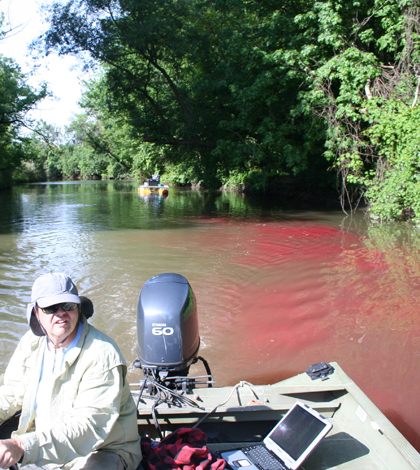Onondaga Lake dye tracer studies make sense of plunging tributaries

Monitoring boat in the channel of Ninemile Creek, downstream of the dye release location. (Credit: Upstate Freshwater Institute)
With Onondaga Lake’s centuries-old legacy of bank-side pollution sources largely in check, the 3,000-acre Central New York lake’s managers are increasingly focused on cutting the nutrient and bacterial pollution coming in from its tributaries.
Recent research on just what happens when those streams hit the lake could change how scientists think about the progress they’re making upstream. Recent dye injection studies in two tributaries shows that their dense, cool inflows dive deep into the lake, a process that some current models don’t accurately capture.
The lake, which sits along the northwest border of Syracuse , N.Y., had been a dumping ground for industrial and municipal waste since Europeans settled in the region in the late 1700s. In the late 1800s, soda ash production facilities began discharging salty wastes into the lake. A chemical company added mercury to the mix in the mid-1900s. Effluent from a wastewater treatment plant built on the southern shore in the 1920s makes up almost 20 percent of the lake’s annual inflow.
Fortunately, water quality has improved since the passing of the Clean Water Act. Both sources of industrial dumping have since stopped, according to Emmet Owens, a senior engineer with the Syracuse-based Upstate Freshwater Institute, a non-profit with a 33-year history of researching Onondaga Lake. Dredging and capping operations are underway to remediate extensive mercury pollution. A series of upgrades to the treatment plant have reduced ammonia, phosphorus and bacteria concentrations.
But things are far from perfect. Onondaga still carries a lake-wide ban on swimming as a result of high bacteria concentrations. Now that the lake-side wastewater plant has upgraded its treatment processes, managers are increasingly focused on what’s coming into the lake from tributaries like Onondaga and Ninemile creeks.
“The treatment plant used to be by far the biggest piece of the pie, and now it’s much smaller,” said Owens. “And the tributaries are, on a relative scale, a much bigger piece.”

View from the location of the dye release site on Ninemile Creek looking toward the mouth of the creek and Onondaga Lake beyond (Credit: Upstate Freshwater Institute)
One reason for that is the tributaries sometimes carry untreated sewage into the lake when the city’s combined sewer system is overflows during storms, contributing to higher nutrient and bacteria concentrations that lead to algae blooms and violations of water quality standards for swimming.
Onondaga County and the New York State Department of Environmental Conservation are working on cutting sewer overflows with green infrastructure installations designed to capture or slow down runoff before it gets to the pipes. But recent research from the Upstate Freshwater Institute shows that the modeling tools that could be used to evaluate that program’s effect on water quality may need serious adjustments.
Those models, Owens said, make the simple assumption that Onondaga and Ninemile creeks flow into the surface waters of the lake, where their loads of phosphorus and bacteria exacerbate algae blooms and swimming standard violations. But a series of dye tracer studies conducted by the Institute show that’s not the case. Instead, a portion of the cold water from the tributaries, which is denser that the warmer water of the lake, immediately plunge into the lake’s deeper layers.

View from the mouth of Ninemile Creek looking out into Onondaga Lake. The outflow from Ninemile Creek, containing dye, disappears a short distance offshore due to plunging of the creek. (Credit: Upstate Freshwater Institute)
Institute researchers injected rhodamine WT dye into the water at the mouths of both creeks on two occasions in 2010. After each injection, crews in boats equipped with rhodamine fluorometers measured more than 200 profiles of dye concentrations in the lake.
Owens said this dye study was different than most, where the bright red dye is highly visible and easy to keep track and measure. In this case, the plunging inflows quickly carried the dye below the surface where the crews couldn’t see it.
“You relied completely on the monitoring equipment to detect where the plume of inflow form the creek was,” Owens said. “They’d be out there for hours at a time not detecting any dye, and then all of a sudden they would find it. That was a challenge in the monitoring.”
The dye studies showed that a significant portion of each stream’s inflow never reaches the lake’s surface waters, a phenomenon Owens and his colleagues successfully modeled in a recent study, the results of which were published in the Journal of the American Water Resources Association.

In addition to boat surveys, a buoy automatically measured vertical distribution of dye concentration in Onondaga Lake, near the mouth of Onondaga Creek (Credit: Upstate Freshwater Institute)
Since the algae blooms fueled by phosphorous only grow in the surface water where light is strong enough to drive photosynthesis, and since bacterial standards only apply to surface waters where swimming occurs, assuming that Onondaga’s tributaries flow into the lake’s surface will make matters appear worse than they actually are.
“What we found here is that making that assumption will result in a significant, over-prediction of the impact of these tributaries on bacteria concentrations in the surface waters of the lake, which is where those standards apply,” Owens said.
Since that assumption is built into some existing models used to estimate the impact of tributaries on the surface waters of the lake, it could lead to problems when it comes time to evaluate whether the green infrastructure initiatives are doing enough to curb pollution from sewer overflows.
“It’s a big enough of an effect that it could certainly have a significant impact on the success of that program,” he said.





0 comments